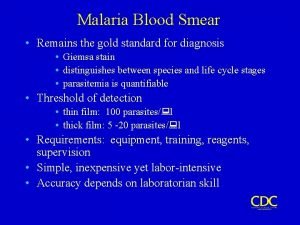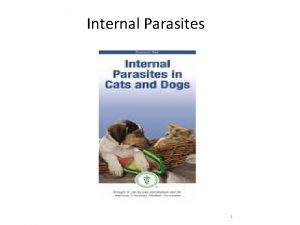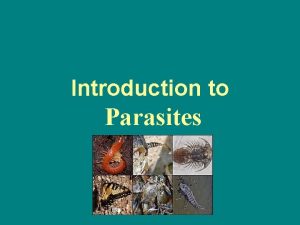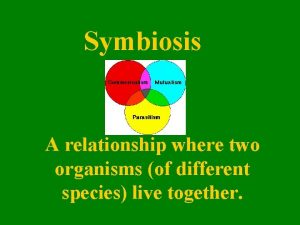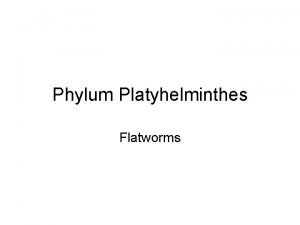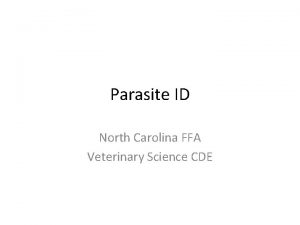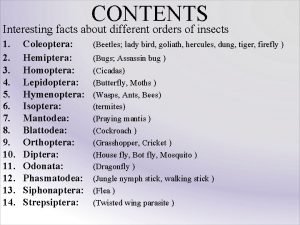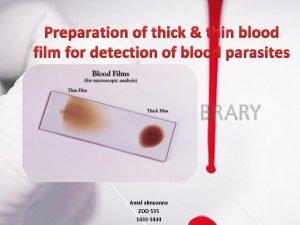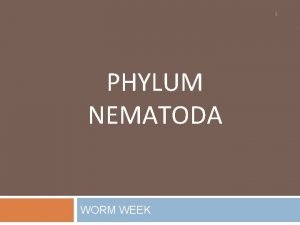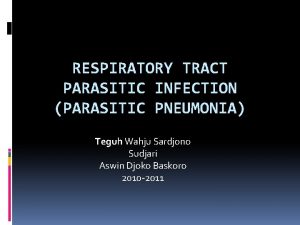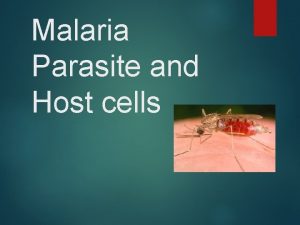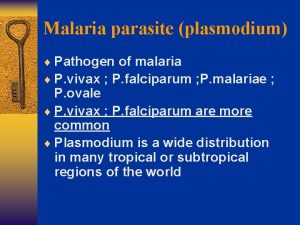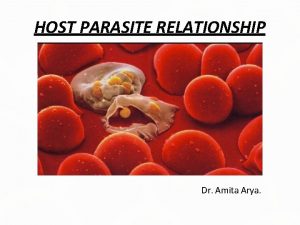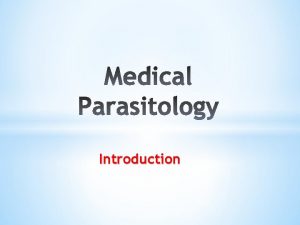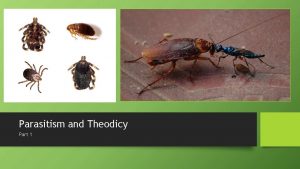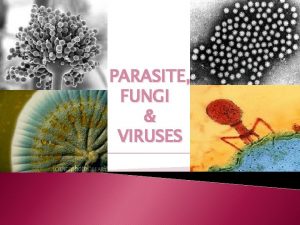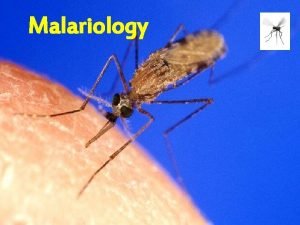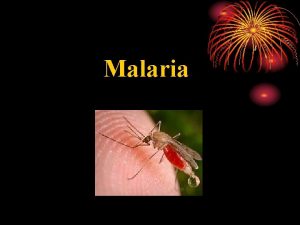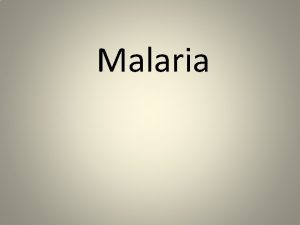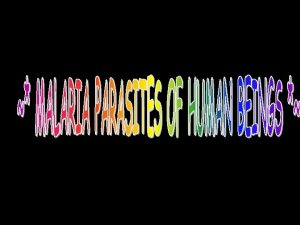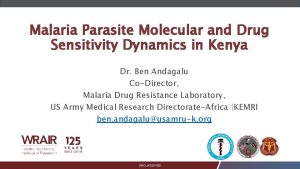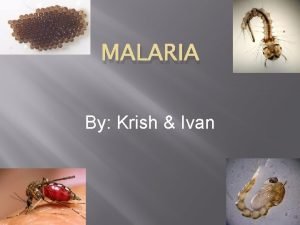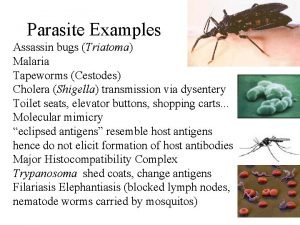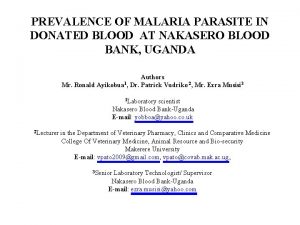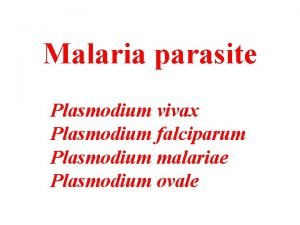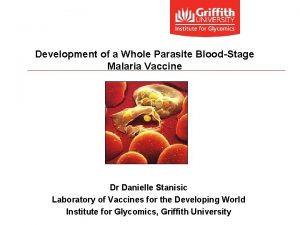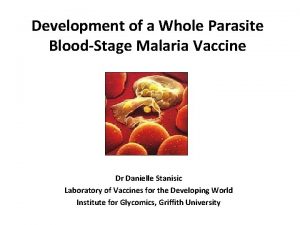Malaria Parasite and Host cells Introduction Malaria is



































- Slides: 35

Malaria Parasite and Host cells

Introduction Malaria is a protozoal disease transmitted by the bite of female Anopheles mosquito, caused by a parasitic protozoon of the genus Plasmodium, which infect human and insect hosts alternatively Plasmodium is a protozoan parasite belonging to the order Sporozoa. Four Plasmodium species can infect man: P. vivax P. falciparum P. ovale P. malariae

Falciparum most Dangerous Falciparum accounts for 90% of deaths due to malaria and vivax is the most widely spread species because it exists in both temperate and tropical climates. The malaria life cycle is a complex system with both sexual and asexual aspects.

Malaria Name is derived from Italian Mal’ aria or bad air Malaria continues to be most important cause of fever and morbidity in the Tropical world Malaria has been eradicated from Europe, Most of North America, USA, South America, Korea and Japan.

Medical importance Malaria remains the world's most devastating human parasitic infection. Malaria affects over 40% of the world's population. WHO, estimates that there are 350 - 500 million cases of malaria worldwide, of which 270 - 400 million are Falciparum malaria, the most severe form of the disease.

Malaria Kills more people than AIDS Malaria kills in one year what AIDS kills in 15 years. For every death due to HIV/AIDS there about 50 deaths due to malaria. To add to the problem is the increasing drug resistance to the established drug.

Ronald Ross In August 20 th, 1897, Ronald Ross, a British officer in the Indian Medical Service, was the first to demonstrate that malaria parasites could be transmitted from infected patients to mosquitoes For his discovery, Ross was awarded the Nobel Prize in 1902.

Pthogenesis of Malaria Events in Humans start with Bite of Mosquito

Malaria Life Cycle Man: Intermediate host. Mosquito: Definitive host – Sporozoites are infective stages Present in the salivary gland of female anopheles mosquito After bite of infected mosquito sporozoites are introduced into blood circulation.

Malaria Life Cycle Sporogony Oocyst Sporozoites Mosquito Salivary Gland Zygote Exoerythrocytic (hepatic) cycle Gametocytes Erythrocytic Cycle Schizogony

Affinity of Parasite to Erythrocytes P. vivax P. malariae P. ovale P. Infectes only young or old erythocytes falciparum Infects all age groups Also adhere to the endothelial lining of Blood vessels Causes the obstruction, Thrombosis and Local Ischemias

Erythrocytic cycle Ruptured cells release Merozoites which attack new red cells Continue with Schizogony Repeated cycles will continue In P. falciparum - infected erythrocytes with schizonts aggregate in the capillaries of brain and other internal organs Only ring forms are seen in the blood smears

Host Erythrocyte Invasion Four distinct steps in the invasion process can be recognized : initial merozoite binding reorientation and erythrocyte deformation junction formation parasite entry

Initial merozoite binding involves reversible interactions between merozoite surface proteins and the host erythrocyte. The exact roles of MSP 1 and other merozoite surface proteins are not known

reorientation and erythrocyte deformation & junction formation After binding to the erythrocyte the merozoite reorients itself so that the apical end of the merozoite being juxtaposed to the erythrocyte membrane. The rhoptries are discharged immediately after the micronemes and the release of their contents correlate with the formation of the parasitophorous vacuole.

reorientation and erythrocyte deformation. Receptor/Ligand Interactions parasite proteins are probably in receptor-ligand Species Host Receptor involved Merozoite Ligand &Thejunction formation interactions with proteins exposed on the erythrocyte surface P. falciparum glycophorins (sialic acid) EBA-175 (erythrocyte – binding antigen ) P. vivax Duffy antigen DBP ( Duffy –binding protein) P. knowlesi Ligand : any molecule that binds to another

parasite entry Immediately after attatchment and junction formation , Ookinetes do not form a Erythrocyte membrane proteins are redistributedparasitophorous so that the vacuole within contact area is free of erythrocyte membrane proteins. the mosquito midgut epithelial cells (PVM) forms in this area , the junction between the parasite and host becomes ring-like Similarly, sporozoites can enter and hepatocytes Because theexit Ookinetes lack The rhoptries proteins plays important role in the formation of without forming a vacuole , rhoptries the PVM. but development into the exoerythrocytic schizont requires PVM formation Movement of the merozoite through the ring-shaped tight junction formed by the receptor/ligand complex. The force is generated by myosin motors associated with the trans-membrane parasite ligands moving along actin filaments within the parasite After the parasite crawls into erythrocyte and completed entry , the PVM and host erythrocyte membranes will separate , and the junction will disappear.

HOST ERYTHROCYTE MODIFICATION Once inside of the erythrocyte, the parasite undergoes a trophic phase During followed by replicative phase presumably intraerythrocytic period, the parasite modifies the host reflecting the make it a more suitable habitat needs of an actively growing parasite to For example : the erythrocyte membrane becomes more permeable to small molecular weight metabolites Knobs and Cytoadherence

HOST ERYTHROCYTE MODIFICATION Knobs and Cytoadherence A major structural. The alteration the believed host erythrocyte are 'knobs', on knobsof: are the erythrocyte membrane falciparum-infected cells. to serve asofa P. focal point for several parasite particular : the cytoadherence of infected proteins areerythrocytes responsibletofor knobs formation endothelial cells ( lining blood vessels ) the knob-associated histidine rich protein (KAHRP) , in erythrocyte membrane protein-2 (Pf. EMP 2) These protein interact with the submembrane cytoskeleton of the erythrocyte (by receptors ) leading to knobs formation

Several possible receptors have been identified in the infected erythrocytes , as: CD 36 ICAM 1 CSA Glycoprotein found on : monocytes, platelets and endothelial cells. Infected erythrocytes from most (intracellular adhesion molecule-1) parasite isolates bind to CD 36. is expressed insulfate the brain (Chondroitin A)on iscapillaries a receptor CD 36 is not expressed the & correlated better with cerebral found in thecells placenta and capillaries may endothelial of brain. malaria contribute to the adverse affects of P. falciparum during pregnancy. The cytoadherence to endothelial cells confers at least two advantages for the parasite: a microaerophilic environment which is better suited for parasite metabolism avoidance of the spleen and subsequent destruction.

Cycles differs in Different species Cycle repeats every 48 hours in 1 P. falciparum 2 P. ovale 3 P. vivax Repeats every 72 hours In P. malariae

Malaria A Major Health problem of Tropical countreis

Clinical Manifestations are related to cycle of events in relation to RBC

Characteristics of a malaria attack Fever and shivering. The attack begins with fever, with the temperature rising as high as 40ºC and falling again over a period of several hours. A poor general condition, feeling unwell and having headaches like influenza. Diarrhea, nausea and vomiting often occur as well.

Clinical manifestations of Malaria Fever Sweating Anemia Splenomagaly (enlarged spleen) Irratability Coma, Retinal Hemorrages Algid Malaria ( a shocklike syndrome) Respiratory distress syndrome

In highly endemic areas: high mortality among children due to severe anemia, children who survive beyond the first years show decreasing parasitemia and disease (this immunity is not sterile and depends on constant exposure)

Cytokines & toxins z Malaria produces a strong Th-1 type response z Elevated serum levels of IFNg and TNFa z Cytokines can induce (mimic) many of the symptoms and signs of malaria (shivering, headache, chills, spiking fever, sweating, vasodilation, hypoglycemia)

Pernicious, Malignant Malaria Is a life threatening complication in acute falciparum malaria It is due to heavy parasitization Manifests with: 1 - Cerebral malaria – it presents with hyperpyrexia, coma and paralysis. Brain is congested. 2 Algid malaria – presents with clammy (cold) skin due to peripheral circulatory failure.

Cerebral Malaria Malignant malaria can affect the brain and the rest of the central nervous system. It is characterized by changes in the level of consciousness, convulsions and paralysis.

Cerebral Malaria Presents with Hyperpyrexia Can lead to coma Paralysis and other complications. Brain appears congested

Pathogenesis of Cerebral malaria z High cytokine levels could be toxic on their own z High levels of cytokine also enhance the second process thought to be responsible for cerebral malaria: sequestration of infected RBCs

Sequestration & cytoadherence Rosetting (adhesion of infected RBCs to other RBCs) and clumping (adhesion between infected cells) was first observed in in vitro culture

Black water fever It is a manifestation of infection with P. falciparum (malignant malaria) A large number of the red blood corpuscles are destroyed. Hemoglobin from the blood corpuscles is excreted in the urine, which therefore is dark and almost the color of cola.

Why Falciparum Infections are Dangerous Can produce fatal complications, 1. Cerebral malaria 2. Malarial hyperpyrexia 3. Gastrointestinal disorders. 4. Algid malaria 5 Black water fever can lead to death

Complication of P. malariae Can produce Nephrotic syndrome Affects mainly children of years age
 Gold standard for diagnosis of malaria
Gold standard for diagnosis of malaria A definitive host harbors which stage of a parasite
A definitive host harbors which stage of a parasite Definitive host vs intermediate host
Definitive host vs intermediate host Parasite introduction
Parasite introduction Onodi cells and haller cells
Onodi cells and haller cells Chlorocruorin
Chlorocruorin Plant and animal cell venn diagram
Plant and animal cell venn diagram Masses of cells form and steal nutrients from healthy cells
Masses of cells form and steal nutrients from healthy cells Transport maximum
Transport maximum Parafollicular cells vs follicular cells
Parafollicular cells vs follicular cells Haploid and diploid venn diagram
Haploid and diploid venn diagram Why dna is more stable than rna?
Why dna is more stable than rna? Is bacteria prokaryotic or eukaryotic
Is bacteria prokaryotic or eukaryotic Prokaryotic cells vs eukaryotic cells
Prokaryotic cells vs eukaryotic cells Cell organelle jeopardy
Cell organelle jeopardy Younger cells cuboidal older cells flattened
Younger cells cuboidal older cells flattened 4 types of eukaryotic cells
4 types of eukaryotic cells Is a staphylococcus cell prokaryotic or eukaryotic
Is a staphylococcus cell prokaryotic or eukaryotic Nondisjunction in meiosis
Nondisjunction in meiosis Cells cells they're made of organelles meme
Cells cells they're made of organelles meme Remora fish symbiotic relationship
Remora fish symbiotic relationship Mutualism example
Mutualism example Stds that cannot be cured
Stds that cannot be cured An unlikely parasite: the mistletoe answer key
An unlikely parasite: the mistletoe answer key Are platyhelminthes acoelomates
Are platyhelminthes acoelomates Dipylidium
Dipylidium Ghost shrimp anatomy
Ghost shrimp anatomy Parasite consumer
Parasite consumer Do beetles taste like apples
Do beetles taste like apples Parasite structure
Parasite structure Parasite std
Parasite std Parasite in blood smear
Parasite in blood smear Parasite
Parasite Entrobiasis
Entrobiasis Ascaris
Ascaris Dr aswin djoko baskoro
Dr aswin djoko baskoro
